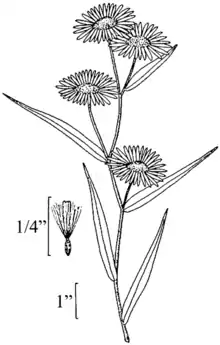Symphyotrichum boreale
Symphyotrichum boreale (syn. Aster borealis) is a species of flowering plant in the family Asteraceae native to North America. Common names include rush aster, northern bog aster and slender white aster.[1]
| Symphyotrichum boreale | |
|---|---|
.jpg.webp) | |
| Scientific classification | |
| Kingdom: | Plantae |
| Clade: | Tracheophytes |
| Clade: | Angiosperms |
| Clade: | Eudicots |
| Clade: | Asterids |
| Order: | Asterales |
| Family: | Asteraceae |
| Genus: | Symphyotrichum |
| Species: | S. boreale |
| Binomial name | |
| Symphyotrichum boreale | |
| Synonyms | |
| |
Description

Symphyotrichum boreale is a perennial herbaceous species between 13 and 85 cm tall. The leaves, stem, and overall plant form are slender, and it produces long rhizomes. The inflorescence consists of one to several composite flowers. The ray florets are white to pale purple and the disc florets are cream or pale yellow-coloured, becoming purplish.[1]
Taxonomy
Symphyotrichum boreale was formerly included in the large genus Aster as Aster borealis. However, this broad circumscription of Aster is polyphyletic and the North American asters are now mostly classified in Symphyotrichum and several other genera.[2]
Hybrids between this species and Symphyotrichum puniceum have been recorded, and are called Symphyotrichum ×longulum.[1]
Distribution and habitat
Symphyotrichum boreale is native to northern North America from Alaska to Newfoundland, and south to Colorado and West Virginia. It is found in wet, calcareous habitats including fens, marshes, swamps and wet meadows.
Ecology
In addition to vegetative spread via rhizomes, dispersal is accomplished by wind-blown seed.
The roots are colonised by fungi including arbuscular mycorrhiza and dark septate endophytes. The sac fungus Erysiphe cichoracearum, which causes a powdery mildew, is also known from this species.[3]
References
- Brouillet, Luc; Semple, John C.; Allen, Geraldine A.; Chambers, Kenton L.; Sundberg, Scott D. (2006). "Symphyotrichum boreale". In Flora of North America Editorial Committee (ed.). Flora of North America North of Mexico (FNA). 20. New York and Oxford – via eFloras.org, Missouri Botanical Garden, St. Louis, MO & Harvard University Herbaria, Cambridge, MA.
- Semple, J.C. "An overview of "asters" and the Tribe Astereae". University of Waterloo. Retrieved 22 January 2020.
- Les, Donald H. (2017). Aquatic Dicotyledons of North America: Ecology, Life History, and Systematics. CRC Press. ISBN 9781482225020.
External links
 Media related to Symphyotrichum boreale at Wikimedia Commons
Media related to Symphyotrichum boreale at Wikimedia Commons Data related to Symphyotrichum boreale at Wikispecies
Data related to Symphyotrichum boreale at Wikispecies
